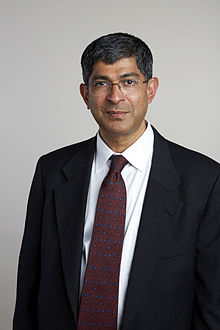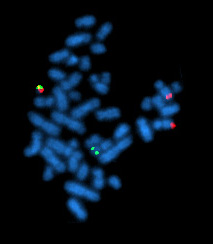
The Philadelphia chromosome or Philadelphia translocation (Ph) is a specific genetic abnormality in chromosome 22 of leukemia cancer cells. This chromosome is defective and unusually short because of reciprocal translocation, t(9;22)(q34;q11), of genetic material between chromosome 9 and chromosome 22, and contains a fusion gene called BCR-ABL1. This gene is the ABL1 gene of chromosome 9 juxtaposed onto the breakpoint cluster region BCR gene of chromosome 22, coding for a hybrid protein: a tyrosine kinase signaling protein that is "always on", causing the cell to divide uncontrollably by interrupting the stability of the genome and impairing various signaling pathways governing the cell cycle.
B. Montgomery "Monte" Pettitt is the Director of the Sealy Center for Structural Biology and Molecular Biophysics at University of Texas Medical Branch in Galveston, Texas, holder of the Robert A. Welch Distinguished Chair in Chemistry, and tenured Professor in the Department of Biochemistry and Molecular Biology, as well as the department of Pharmacology and Toxicology. He is also affiliated with and former director of The W. M. Keck Center at Rice University, and a faculty member of the Structural and Computational Biology and Molecular Biophysics program at Baylor College of Medicine. At the University of Houston, he was the Hugh Roy and Lille Cranz Cullen Distinguished Professor of Chemistry and Robert A. Welch Chair in Chemistry, as well as the director of its Institute for Molecular Design.

Chemical biology is a scientific discipline between the fields of chemistry and biology. The discipline involves the application of chemical techniques, analysis, and often small molecules produced through synthetic chemistry, to the study and manipulation of biological systems. Although often confused with biochemistry, which studies the chemistry of biomolecules and regulation of biochemical pathways within and between cells, chemical biology remains distinct by focusing on the application of chemical tools to address biological questions.

Martin Karplus is an Austrian and American theoretical chemist. He is the Director of the Biophysical Chemistry Laboratory, a joint laboratory between the French National Center for Scientific Research and the University of Strasbourg, France. He is also the Theodore William Richards Professor of Chemistry, emeritus at Harvard University. Karplus received the 2013 Nobel Prize in Chemistry, together with Michael Levitt and Arieh Warshel, for "the development of multiscale models for complex chemical systems".
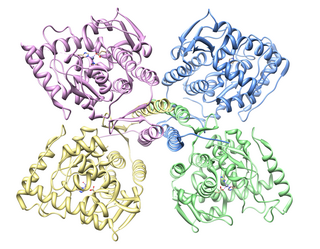
Tyrosine hydroxylase or tyrosine 3-monooxygenase is the enzyme responsible for catalyzing the conversion of the amino acid L-tyrosine to L-3,4-dihydroxyphenylalanine (L-DOPA). It does so using molecular oxygen (O2), as well as iron (Fe2+) and tetrahydrobiopterin as cofactors. L-DOPA is a precursor for dopamine, which, in turn, is a precursor for the important neurotransmitters norepinephrine (noradrenaline) and epinephrine (adrenaline). Tyrosine hydroxylase catalyzes the rate limiting step in this synthesis of catecholamines. In humans, tyrosine hydroxylase is encoded by the TH gene, and the enzyme is present in the central nervous system (CNS), peripheral sympathetic neurons and the adrenal medulla. Tyrosine hydroxylase, phenylalanine hydroxylase and tryptophan hydroxylase together make up the family of aromatic amino acid hydroxylases (AAAHs).

ZAP-70 is a protein normally expressed near the surface membrane of lymphocytes. It is most prominently known to be recruited upon antigen binding to the T cell receptor (TCR), and it plays a critical role in T cell signaling.
The Richard Lounsbery Award is given to American and French scientists, 45 years or younger, in recognition of "extraordinary scientific achievement in biology and medicine."
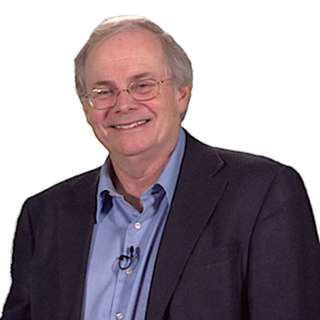
Gregory A. Petsko is an American biochemist and member of the National Academy of Sciences, the National Academy of Medicine, the American Academy of Arts and Sciences, and the American Philosophical Society. He is currently Professor of Neurology at the Ann Romney Center for Neurologic Diseases at Harvard Medical School and Brigham and Women's Hospital. He formerly had an endowed professorship in Neurology and Neuroscience at Weill Cornell Medical College and is still an adjunct professor of Biomedical Engineering at Cornell University, and is also the Gyula and Katica Tauber Professor, Emeritus, in biochemistry and chemistry at Brandeis University. On October 24, 2023, in a ceremony in the East Room of the White House, President Joe Biden presented Gregory Petsko and eight others with the National Medal of Science, the highest honor the United States can bestow on a scientist and engineer.
Axel T. Brunger is a German American biophysicist. He is Professor of Molecular and Cellular Physiology at Stanford University, and a Howard Hughes Medical Institute Investigator. He served as the Chair of the Department of Molecular and Cellular Physiology (2013–2017).

Tyrosine-protein kinase HCK is an enzyme that in humans is encoded by the HCK gene.

General transcription factor II-I is a protein that in humans is encoded by the GTF2I gene.

JoAnne Stubbe is an American chemist best known for her work on ribonucleotide reductases, for which she was awarded the National Medal of Science in 2009. In 2017, she retired as a Professor of Chemistry and Biology at the Massachusetts Institute of Technology.
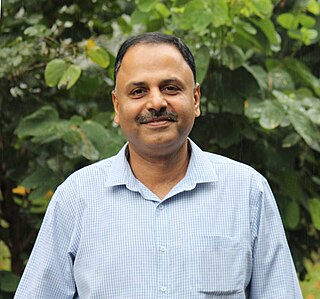
Rajan Sankaranarayanan is an Indian structural biologist and a group leader at the Centre for Cellular and Molecular Biology (CCMB) in Hyderabad. He is known for his research in the field of protein translation, especially for his contribution in chiral proofreading during protein biosynthesis. In 2020, Sankaranarayanan was awarded the Infosys Prize in life sciences, the most prestigious award that recognizes achievements in science and research, in India.

Stephen C. Harrison is professor of biological chemistry and molecular pharmacology, professor of pediatrics, and director of the Center for Molecular and Cellular Dynamics of Harvard Medical School, head of the Laboratory of Molecular Medicine at Boston Children's Hospital, and investigator of the Howard Hughes Medical Institute.

Anthony Rex Hunter is a British-American biologist who is a professor of biology at the Salk Institute for Biological Studies and the University of California San Diego. His research publications list his name as Tony Hunter.
Susan Taylor is an American biochemist who is a Professor of Chemistry and Biochemistry and a Professor of Pharmacology at the University of California, San Diego. She is known for her research on protein kinases, particularly protein kinase A (PKA). She was elected to the Institute of Medicine and the United States National Academy of Sciences in 1996.
James Michael Berger is an American academic working as a professor of biophysics and biophysical chemistry at Johns Hopkins University School of Medicine, where he is also the co-director of the Cancer Chemical and Structural Biology Program at the Sidney Kimmel Comprehensive Cancer Center and the director of the Johns Hopkins Institute for Basic Biomedical Sciences. His main area of research is the functions of molecular cellular machinery.
Barry H. Honig is an American biochemist, molecular biophysicist, and computational biophysicist, who develops theoretical methods and computer software for "analyzing the structure and function of biological macromolecules."
Jack Dixon is the Distinguished Professor of Pharmacology, Cellular & Molecular Medicine, Chemistry & Biochemistry at the University of California San Diego School of Medicine.
